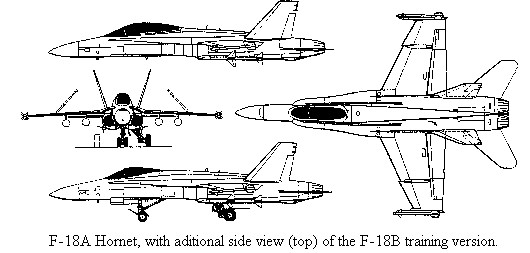



McDonnel Douglas made a study of these aircraft and concluded that the YF-17 could be redesigned at minimum costs to meet the Navy's requirements. It then teamed with Northrop with McDonnel Douglas as the prime contractor. Identified as the Navy Air Combat Fighter (NACF), this received the designation F-18 Hornet when selected for further development.
The first Hornet was rolled out on 13 September 1978, and made it's first flight on 18 November 1978. The second flew on 12 March 1979 and all 11 development aircraft were flying by March 1980, including two TF-18A two-seat combat-capable trainers. The F-18 became fully operational in 1982.
Type
Single-seat carrier based naval strike fighter, two-seat trainer with combat capability.
Designations
Two General Electric F404-GE-400 low-bypass turbofan engines.
Accommodation
Pilot-only in F/A-18A. Two-seat tandem in F/A-18B
Armament
Nine external weapon stations with a combined capacity of 7,710 kg (17,000 lb) of mixed ordnance at high g. Two wingtip stations for Aim-9 Sidewinder air-to-air missiles; two outboard wing stations for air-to-air or air-to-ground weapons, including Aim-120 Amraams. An M61 20mm six-barrel gun with 570 rounds is mounted in the nose.
Dimensions
Wing span: 11.43m (37ft, 6 inch)
Length overall: 17.07m (56ft)
Height overall: 4.66m (15ft, 3.5 inch)
Weights
Fighter mission: 15,234 kg (33.585 lb)
Attack mission: 21,319 kg (47.000 lb)
Performance
Max. level speed: More than Mach 1.8
Approach speed: 130 knots (240 km/h, 150 mph)
Ceiling: 15,240 m (50000 ft) Combat radius: more then 400 nm (740 km, 460 miles)